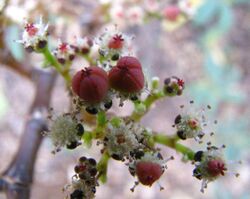Biology:Euphorbia celastroides
| Euphorbia celastroides | |
|---|---|

| |
| Chamaesyce celastroides (inflorescence) | |
| Scientific classification | |
| Kingdom: | Plantae |
| Clade: | Tracheophytes |
| Clade: | Angiosperms |
| Clade: | Eudicots |
| Clade: | Rosids |
| Order: | Malpighiales |
| Family: | Euphorbiaceae |
| Genus: | Euphorbia |
| Species: | E. celastroides
|
| Binomial name | |
| Euphorbia celastroides Boiss.
| |
| Synonyms[1] | |
|
List
| |
Euphorbia celastroides is a flowering plant in the family Euphorbiaceae.[1] It is referred to by the common name 'akoko by Hawaiians, and is a species of spurge closely related to the poinsettia.[2] This species develops into a round-shape shrub. This species is endemic to the Hawaiian Islands.
Description
Euphorbia celastroides grows as a medium-sized shrub or small tree reaching 2 metres (6.6 ft) in height.[3] To grow properly, this species requires temperatures of 15 °C (59 °F) and light shade.[4] This plant develops in a fashion similar to a shrub. In the summer, it assumes a red-violet colouring. It does not lose its leaves in the winter, due to the warm climate of its range. Female flowers have a three-part pistil over a three-part ovary, usually producing three (or sometimes more) seeds.[4] This species is tolerant of heat and drought. They are susceptible to fungal diseases. Its cyathia may be located in short or open-branched cymes, or remain ungrouped in leaf axils. The leaves are distichous (grow in two vertical rows) and may have a glaucous coating. This plant produces a green or brown, rounded fruit 2 to 4 mm long, containing grey-brown seeds 0.5 to 2.5 mm long.[3]
Distribution and habitat
Most varieties of this species can only be found in the Hawaiian Islands.[5][6] E. celastroides is tolerant of drought and grows in dry areas, inland as well coastal.[7] This species is endemic to the polihale and kanaio regions of Kauai and Maui.[8]
Conservation
Euphorbia celastroides has not yet been evaluated by the IUCN.[9] However, due to its endemic nature, it is very vulnerable to human threats. Two examples of such threats are four-wheeled vehicles (which crush the plant) and introduced species (which compete for resources).[8]
Varieties
This plant has many varieties. These varieties include:[10]
- Var. amplectens
- Var. halawana
- Var. hanapepensis
- Var. haupuana
- Var. humbertii
- Var. ingrata
- Var. kaenana
- Var. kohalana
- Var. laehiensis
- Var. lorifolia
- Var. mauiensis
- Var. nelsonii
- Var. nematopoda
- Var. niuensis
- Var. pseudoniuensis
- Var. saxicola
- Var. typica
- Var. waikoluensis
References
- ↑ Jump up to: 1.0 1.1 "Euphorbia celastroides Boiss.". The Trustees of the Royal Botanic Gardens, Kew. n.d.. https://powo.science.kew.org/taxon/urn:lsid:ipni.org:names:345976-1.
- ↑ "Euphorbiaceae at hawaii.edu". http://www.botany.hawaii.edu/Faculty/Carr/euphorbi.htm.
- ↑ Jump up to: 3.0 3.1 Hawaiian flora at botany.si.edu
- ↑ Jump up to: 4.0 4.1 E. celastroides at ZipCodeZoo
- ↑ Wagner, W.; D. Herbst; S. Sohmer (1990). Manual of the flowering plants of Hawaii. Honolulu: University of Hawaii Press. pp. 1853. ISBN 978-0-8248-1152-5.
- ↑ USDA.gov on Var.kaenana
- ↑ Mitchell, Andrew W. (1989). The fragile South Pacific: an ecological odyssey. Austin, TX: University of Texas Press. p. 167. ISBN 978-0-292-72466-2. https://books.google.com/books?id=_wPMHXvWiEIC&pg=PA167. Retrieved 5 October 2009.
- ↑ Jump up to: 8.0 8.1 CHAMAESYCE CELASTROIDES COASTAL DRY SHRUBLAND at hawaii.edu
- ↑ Chamaesyce celastroides at EOL.org
- ↑ Euphorbia on SageBud[yes|permanent dead link|dead link}}]
Wikidata ☰ Q5410407 entry
 |


